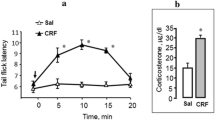We report here our studies of the contribution of the hypothalamo-hypophyseal-adrenocortical system (HHACS) and opioid system to the analgesic effect of corticotropin-releasing factor (CRF) in conscious rats exposed to thermal stimuli. Two methodological approaches were used: 1) blockade of the functional activity of the HHACS by administration of hydrocortisone at a pharmacological dose one week before experiments; 2) blockade of glucocorticoid receptors with the glucocorticoid receptor antagonist RU38486. The contribution of the opioid system was studied by blockade of opioid receptors with their antagonist naltrexone. Blockade of opioid receptors completely eliminated the analgesic effect of CRF, blockade of the functional activity of the HHACS decreased it, and blockade of glucocorticoid receptors increased the effect. These data provide evidence that the analgesic effect of CRF in conscious rats exposed to a thermal stimulus is mediated by an opioid-associated mechanism. The actions of opioids on pain sensitivity may be modulated by glucocorticoid hormones.
Similar content being viewed by others
References
A. I. Bogdanov and N. I. Yarushkina, “Mechanisms of the influence of adrenocorticotropic hormone on pain sensitivity in rats,” Ros. Fiziol. Zh. im. I. M. Sechenova, 88, No. 5, 596–601 (2002).
A. I. Bogdanov and N. I. Yarushkina, “The role of adrenocorticotropic hormone in inhibiting pain reactions in conscious rats,” Ros. Fiziol. Zh. im. I. M. Sechenova, 89, No. 1, 60–65 (2003).
A. I. Bogdanov and N. I. Yarushkina, “The role of hypothalamohypophyseal-adrenocortical system hormones in the analgesic effect of corticotropin-releasing hormone,” Ros. Fiziol. Zh. im. I. M. Sechenova, 92, No. 2, 262–270 (2006).
L. P. Filaretova, T. T. Podvigina, T. R. Bagaeva, and A. A. Filaretova, “Prolonged suppression of hypothalamo-hypophyseal-adrenocortical system function in rats,” Ros. Fiziol. Zh. im. I. M. Sechenova, 81, No. 1 24–31 (1995).
N. I. Yarushkina, “The role of hypothalamo-hypophyseal-adrenocortical system hormones in controlling pain sensitivity,” Ros. Fiziol. Zh. im. I. M. Sechenova, 93, No. 11, 1252–1262 (2007).
N. I. Yarushkina, T. R. Bagaeva, and L. P. Filaretova, “The analgesic action of corticotropin-releasing factor (CRF) on somatic pain sensitivity: involvement of glucocorticoid and CRF-2 receptors,” Ros. Fiziol. Zh. im. I. M. Sechenova, 94, No. 10, 1118–1125 (2008).
F. J. Atesta and K. E. Nikolarakis, “Peripheral but not intracerebroventricular corticotropin-releasing hormone (CRH) produces antinociception which is not opioid mediated,” Brain Res., 503, No. 2, 219–224 (1989).
A. Capasso and A. Loizzo, “Functional interference of dexamethasone on some morphine effects: hypothesis for the steroid-opioid interaction,” Recent Pat. CNS Drug Discov., 3, No. 2, 138–150 (2008).
A. Capasso, A. Di Giannuario, A. Liozzo, S. Pieretti, and L. Sorrentino, “Central interaction of dexamethasone and RU-38486 on morphine antinociception in mice,” Life Sci., 51, No. 14, PL 139–143 (1992).
M. S. Cepeda, I. Bonney, J. Moyano, and D. B. Carr, “Corticotropinreleasing hormone (CRH) produces analgesia in a thermal injury model independent of its effect on systemic beta-endorphin and corticosterone,” Regul. Pept., 118, No. 1–2, 39–43 (2004).
R. C. Gaillard, A. Riondel, A. F. Muller, W. Hermann, and E. E. Baulieu, “RU 486: A steroid with antiglucocorticosteroid activity that only disinhibits the human pituitary-adrenal system at a specific time of day,” Proc. Natl. Acad. Sci. USA, 81, 3879–3882 (1984).
K. M. Hargreaves, C. D. Flores, and G. Mueller, “The role of pituitary beta-endorphin in mediating CRF-induced antinociception,” Am. J. Physiol., 258, No. 2, E235–E242 (1990).
L. P. Filaretova, T. R. Bagaeva, and G. B. Makara, “Aggravation of nonsteroidal anti-inflammatory drug gastropathy by glucocorticoid deficiency or blockade of glucocorticoid receptor in rats,” Life Sci., 71, No. 21, 2457–2468 (2002).
A. L. Kirchgessner, R. J. Bodnar, and G. W. Pasternak, “Naloxazone and pain-inhibitory systems: evidence for a collateral inhibition model,” Pharmacol. Biochem. Behav., 17, No. 6, 1175–1179 (1982).
W. R. Lariviere and R. Melzack, “The role of corticotropin-releasing factor in pain and analgesia,” Pain, 84, No. 1, 1–12 (2000).
D. Le Bars, M. Gozariu, and S. W. Cadden, “Animal models of nociception,” Pharmacol. Rev., 53, 597–652 (2001).
R. Likar, S. A. Mousa, H. Steinkellner,W. Koppert, G. Phillippitsch, C. Stein, and M. Schäfer, “Involvement of intra-articular corticotropin-releasing hormone in postoperative pain modulation,” Clin. J. Pain, 23, No. 2, 136–142 (2007).
R. Batejec, H. Uhlich, C. Hotz, J. Mühling, H. W. Harbach, R. H. Bödeker, G. Hempelmann, and H. Techemacher, “Corticotropin-releasing hormone reduces pressure pain sensitivity in humans without involvement of beta-endorphin (1–31), but does not reduce heat pain sensitivity,” Neuroendocrinology, 82, No. 3–4, 185–197 (2005).
A. Ratka,W. Sutanto, and E. R. De Kloet, “Long-lasting glucocorticoid suppression of opioid-induced antinociception,” Neuroendocrinology, 48, No. 4, 439–444 (1988).
S. Sawamura, M. Obara, K. Takeda, M. Maze, and K. Hanaoka, “Corticotropin-releasing factor mediates the antinociceptive action of nitrous oxide in rats,” Anesthesiology, 99, No. 3, 708–715 (2003).
I. Takasaki, T. Kurihara, H. Saegusa, S. Zong, and T. Tanabe, “Effects of glucocorticoid receptor antagonists on allodynia and hyperalgesia in mouse model of neuropathic pain,” Eur. J. Pharmacol., 524, No. 1–3, 80–83 (2005).
J. P. Vit, D. J. Clauw, T. Moallem, A. Boudah, P. T. Ohara, and L. Jasmin, “Analgesia and hyperalgesia from CRF receptor modulation in the central nervous system of Fischer and Lewis rats,” Pain, 121, No. 3, 241–260 (2006).
N. I. Yarushkina, A. I. Bogdanov, and L. P. Filaretova, “Somatic pain sensitivity during formation and healing of acetic acid-induced gastric ulcers in conscious rats,” Auton. Neurosci. Basic and Clinical, 126–127, No. 1–2, 100–105 (2006).
Author information
Authors and Affiliations
Corresponding author
Additional information
Translated from Rossiiskii Fiziologicheskii Zhurnal imeni I. M. Sechenova, Vol. 96, No. 2, pp. 128–137, February, 2010.
Rights and permissions
About this article
Cite this article
Yarushkina, N.I., Bagaeva, T.R. Mechanisms of the Analgesic Effect of Corticotropin-Releasing Factor in Conscious Rats. Neurosci Behav Physi 41, 500–505 (2011). https://doi.org/10.1007/s11055-011-9444-3
Received:
Published:
Issue Date:
DOI: https://doi.org/10.1007/s11055-011-9444-3



